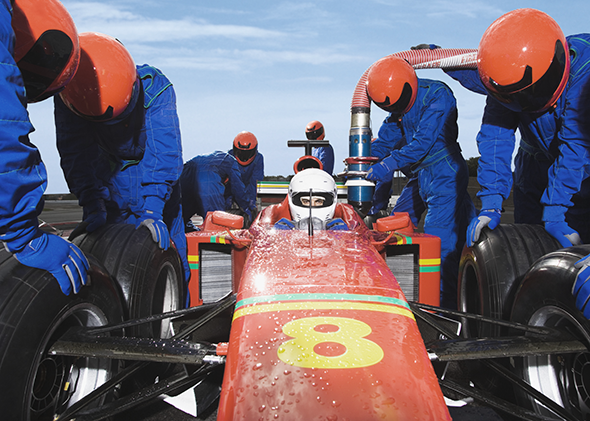
How Electricity Just Changed the World of Formula 1 Racing
Saturday's Formula E race was only the beginning.

Souped-up cars testing the upper limits of their gears. The screech of tires. Smoke emanating from tailpipes. The collective inhalation of breath as thousands of people watch drivers negotiate vehicles around impossibly tight curves at ridiculously high speeds. A dramatic pile-up, as the cars of the leading driver bumped into a challenger on the last lap – causing the challenger to go airbone.
These are the sights and sounds familiar to the world’s legions of Formula 1 racing fans.
And on September 13, some 75,000 spectators in in Beijing witnessed all these visual and audial effects – except for the exhaust and the engine roar. The ten cars that launched from the starting line and careened around a compact 2.1 mile course in Beijing’s Olympic Village, past the iconic Bird’s Nest stadium, were all powered by electricity.
This race officially launched the Formula E series. Sponsored by FIA, which runs the storied Formula 1 races, Formula E (for electric) consists of a ten-race circuit that will take drivers to glamorous locations around the world: Miami, Long Beach, Buenos Aires, Monte Carlo, Berlin and London. Ten teams with two drivers each will compete for the inaugural title.
At first blush, the prospect of a high-speed, hour-long race of electric speedsters going all out might seem contradictory. Most of the electric vehicles on the market are highly utilitarian sedans – like the boxy Nissan Leaf and Chevy Volt – with limited ranges. The Leaf can only go about 80 miles without a charge, while the Volt drains its battery and switches over to gas after about 30 miles. A typical rally of electric cars might involve a bunch of sedans putt-putting sedately through suburban streets. And while the advent of the Tesla has helped make the image of electric vehicles more sporty, owners of such cars generally drive as if they’re under the caution flag. They have to be careful not to crank up the air-conditioning too high, drive too far, or step too heavily on the accelerator – all in order to avoid draining the battery.
But modern car racing is also intricately bound up with advanced technology, engineering, and performance – figuring out ways to coax an extra bit of torque, power, and distance from the available materials and components. And with electricity playing a more important role in innovative automobile transport, including high-end sports cars like the Tesla, many gearheads and auto fans have been drawn to the possibilities of electric racecars. Among the teams participating in Formula E are ones backed by the Andrettis—one of car-racing’s royal families—and Virgin Racing, which is backed by billionaire Richard Branson.
This first season, all teams will be driving versions of the Spark-Renault SRT_01E. Renault is part of an alliance with Nissan, which has been manufacturing and selling the all-electric Leaf, an all-electric passenger car, for several years. But the cars competing in the Formula E bear little resemblance to the Leaf. In fact, they are like a grown-up version of the remote-controlled battery-operated cars that kids love to play with, except they are equipped with a battery capable of producing much more power.
Like traditional Formula 1 racecars, the sleek racers have a series of gears that are shifted through the use of paddles. In these videos of a test drive by driver Lucas De Grassi, and a group test drive at Donington Park in England, the cars feature rocket-like acceleration – going from zero to 60 in three seconds, and zoom around the tight courses at speeds up to 150 miles per hour. (For the true gear-heads, here’s a guide to the specs to the car.)
Formula E imposes new requirements on drivers as well as manufacturers. Since there are no quick pit stops available for refueling, cars can only go as far as the charge will take them. “You can’t just go flat-out like you’d want to drive,” noted driver Mike Conway, who will be competing in Formula E for Dragon Racing. “You really have to look after the power that you have and there are different ways of doing it and still getting a good lap time – and it’s something we are still exploring.”
In addition, Formula E cars will differ in some meaningful ways from their Formula 1 counterparts – beyond the fuel they use. As is the case with electric cars and hybrids, the brakes in Formula E will help recharge the battery when they are applied. Then there’s the sound, which is an issue for spectators and drivers alike. The roar of the motor is a key part of the sport’s visceral attraction. Formula E vehicles produce a consistent high-pitched whine. “Contrary to popular belief, the Formula E cars are far from silent, producing a modern, futuristic sound,” Formula E promises. When the old cars zip around the track they’ll emit 80 decibels of noise, more than a typical gas-powered car does while driving on the highway.
The sound – or relative lack thereof – will also pose a challenge for drivers, for whom the roaring and whining of the motor provides guidance as to when they should shift. Instead, they’ll rely on visual cues. “You always have to be looking at the shift lights to know when to change gear,” as driver Jann Mardenborough put it. “Although there is sound, it’s not like a petrol engine – when you get in tune with the engine noise and you shift gears accordingly – you have to think about the shift lights and everything else.”
In the first race, Formula E provided all the drama of a Formula One race – only without the noise and emissions. Heading into the final lap, Nicolas Prost held a commanding lead. But as he was challenged by Nick Heidfeld, the two cars bumped. Heidfeld’s car went soaring and crashed dramatically. (He wasn’t hurt.) In the wake of the pile-up, Brazilian Lucas de Grassi cruised across the finish line for the victory.
The next race will take place in Malaysia in November.